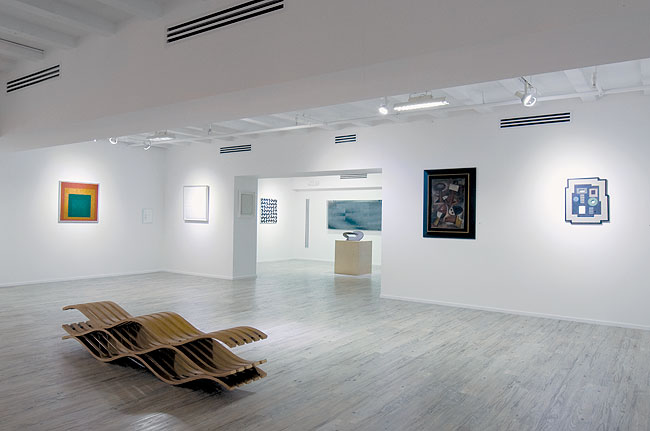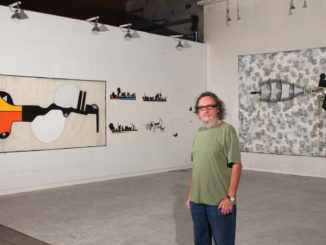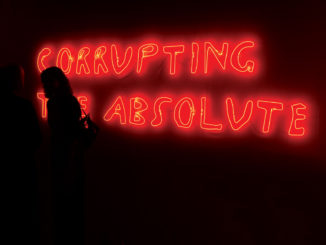The newest art space on Miami’s Design District defies the traditional role of the art gallery
 There has been a subtle parting from the word “gallery” among those in the business of art. New spaces all over Miami are opening their doors under the semblance of an art gallery, but actually defining themselves as something more. Arevalo Gallery in the Design District is such a space. As I visited with owner Francisco Arevalo on a Wednesday afternoon, post Basel mayhem, we talk about a formation that was anything but conventional, the artists he represents, his decision to open a space in Miami, and why his gallery is not really a gallery, but rather a “platform for manifestation”.
There has been a subtle parting from the word “gallery” among those in the business of art. New spaces all over Miami are opening their doors under the semblance of an art gallery, but actually defining themselves as something more. Arevalo Gallery in the Design District is such a space. As I visited with owner Francisco Arevalo on a Wednesday afternoon, post Basel mayhem, we talk about a formation that was anything but conventional, the artists he represents, his decision to open a space in Miami, and why his gallery is not really a gallery, but rather a “platform for manifestation”.
Arevalo’s earlier years and formal education were in medicine; a doctor for most of his life, with a specialized focus on HIV research, he dedicated his time to the vocation he chose as a young man. However, after taking a break from Primary Care to focus solely on research, Arevalo found himself in disagreement with the turn medicine had taken in his absence. “It had become commercial,” he says shaking his head, “being a doctor was no longer about doing what you love, but merely working for the money.”
In light of his realization, and unwillingness to live a settled-for life, Arevalo made a career change that not many would have expected – he became an art dealer. Though his transition was slow and calculated, even selling his first piece, a Lam, while still practicing medicine, it was a clear turn in a new and positive direction.
After forming ties with a group of Italian art dealers, a researcher at heart, Arevalo immersed himself in the investigation of the different art movements of 20th century Europe and Latin America. As he began to understand how and why some of the most renowned artists came to be, he also began paving the road to a truly successful career that has made him an authority in the art world, and even integral in the continued influence of many artists like Fernando Botero and Julio Larraz.
The phrase “knowledge is power” could not be more appropriate when describing Arevalo’s course, as it was his intensive study of art history that led him not only to understand an artist’s trajectory, but to merge his own with it as well. “There has been a continental division established, not only by historical parameters but by the academy as well, yet little is known of the convergences and the inspiration in which these two parallel worlds co-existed,” he says of Europe and Latin America, “in today’s terms, the lines that separated us before have been blurred by technology and a new concept of art history is emerging. We cannot separate ourselves from our geographical circumstances and their influences, yet we all now share a wider stage through which we manifest them.”
It is this – Arevalo’s thirst for knowledge, discerning eye, and extensive roster – that has earned him the extraordinary reputation of being the go-to art dealer to collectors worldwide, dedicating his selections only to the best and most influential. “We choose our artists based on the same principles that any other gallery would,” he explains, “we look for those whose avant-garde message separated them from the conventional thoughts of their era, and through it, challenged the paradigms of their times.”
Though it was clear during our conversation that his experience is extensive, and his ability to acquire and sell classic works, impressive, I wondered and dared ask, what about new artists? Miami has clearly carved a place for itself in the emerging artist circuit, so it would be valid to expect and encourage their presence in almost every gallery in the city. “Well, those elements are found in every generation,” he says, “as of now, we’ve dedicated our efforts into researching and promoting the movements that defined Latin American Modernism; nonetheless, and under the very same premise, we have established a program in which we promote contemporary projects at the international level.”
Arevalo Gallery has supported such projects by Pae White, Andrea Zittel, and Jorge Pardo, as well as a progressive young contemporary group of artists from Mexico formed by (Joaquin Segura, Gonzalo Lebrija, Jose Davila etc.- all of them under the curatorial direction of Jaime Ashida of Arena Mexico Arte Contemporaneo in Guadalajara. In fact, it is this very notion of time and discovery that prompts the clarification of Arevalo Gallery’s presence as what Arevalo calls: a platform for manifestation; “In following the definition,” he explains, “‘manifestation’ is an indication of the existence, reality, or presence of something – a sign of things to come and, at the same time, evidence of what’s already there.”
This year, following a spectacular 2010 opening during Art Basel with “From Absolute to Minimal”, Arevalo will present an exceptionally enlightening series of exhibits. “We have several projects in mind,” he says, “our main exhibits will gravitate around the following ideas: the participation of women in the Concrete and Abstract Geometry movements, the last 10 years of Geometric expression in painting in Argentina andUruguay (the countries that originated the genre through concretism in South America), the evolution of the Multiple from its origins as a form of social expression and its consequential evolution into a mass market production for financial gains, and a curated contemporary show of international artists that have embraced concretism and geometry as the foundation of their works.”
Undoubtedly the plan of a very deliberate breed of art dealer, Arevalo’s 2011 calendar might seem somewhat out of place to those who underestimate our cultural identity. However, when we touch upon this sensitive yet inevitable subject, Arevalo seems anything but concerned saying, “opposite to even our own impression, Miami is not a fragmented cultural entity. On the contrary, it is our multifaceted culture that defines us best, and it should be within this understanding that we exist. Miami needs to show the world that we’re not just a messenger; we’re as much the stage for ideas as we are the source, the inspiration, and the idea itself.”
Originally from El Salvador, Arevalo spent most of his life between Mexico, Europe, and the rest of Latin America, concentrating his efforts more currently in our city through Arevalo Gallery, and imparting his knowledge of a historically symbiotic relationship between European and Latin American Art. He is on a clear mission to communicate the importance of understanding the life of a piece – why it was made, where it was made, and how it came to be here, before our eyes.
When asked: “Why Miami?” He says: “We will always be considered an ‘up and coming’ city, that term will always be used in the context of comparative references and we should adopt it as part of our identity – an always changing city in a stage of permanent experimentation. However, as a scientist, I should add that every form of experimentation conveys results, and Miami is the perfect platform to communicate those; we just have to bring out the courage to do so outside of the two weeks in which we’re the center of the Universe… that’s the challenge.” Agreed.



Be the first to comment